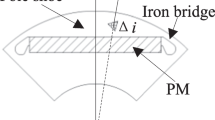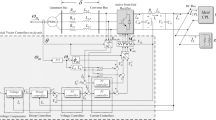Abstract
In this paper, three typical permanent magnet machines for All-Electric aircraft propulsion are designed, optimized and compared. Firstly, the necessary performances are determined based on the requirements of high power/torque density and an aircraft with a maximum takeoff weight of 1500 kg. The initial structures of interior permanent magnet (IPM) synchronous machine, vernier permanent magnet (VPM) machine and flux-switching permanent magnet (FSPM) machine are designed with identical stator outer radius and rotor shaft length. Then, parametric sensitivity analysis and multi-objective particle swarm are combined as an optimization methodology to optimize these machines. Based on the finite element analysis, the electromagnetic performances such as no-load airgap flux density harmonic spectrum, cogging torque, average output torque, losses, efficiency and power factor, etc., are generally compared and analyzed. Subsequently, the discussions are carried out, where the strength and weakness of these three machines are concluded and the future prospects are suggested. Finally, it is concluded that if effective measures are implemented to reduce the permanent magnet eddy current loss and improve the power factor, the VPM machine would be the most suitable choice among these machines for All-Electric aircraft propulsion.









Similar content being viewed by others
Abbreviations
- 3D:
-
Three dimensions
- FEA:
-
Finite element analysis
- FFT:
-
Fast fourier transform
- FSPM:
-
Flux-switching permanent magnet
- IPM:
-
Interior permanent magnet
- MOPSO:
-
Multi-objective particle swarm optimization
- PM:
-
Permanent magnet
- VPM:
-
Vernier permanent magnet
- α PM :
-
Angle of PM [deg]
- α v :
-
Angle of V-shaped PM [deg]
- f 1, f 2, f 3 :
-
Magnetic field path 1, 2, 3 of FSPM machine
- f v 1, f v 2 :
-
Magnetic field path 1, 2 of VPM machine
- g :
-
Airgap length [mm]
- h os :
-
Height of flux barrier [mm]
- h PM :
-
Height of PM [mm]
- h rh :
-
Height of rotor hollow [mm]
- h rt :
-
Height of rotor tooth [mm]
- h s :
-
Height of stator slot [mm]
- h y :
-
Height of stator yoke [mm]
- l b :
-
Length of flux bridge [mm]
- l r :
-
Length of rotor stack [mm]
- M PM :
-
PM mass [kg]
- R ri :
-
Inner rotor radius [mm]
- R ro :
-
Outer rotor radius [mm]
- R so :
-
Outer stator radius [mm]
- V PM :
-
PM volume [cm3]
- w Fe :
-
Width of ferromagnetic rib [deg]
- w msc :
-
Width of modular stator gap [mm]
- w os :
-
Width of flux barrier [deg]
- w PM :
-
Width of PM [mm]
- w q :
-
Width of magnetic bridge [deg]
- w r :
-
Width of rotor yoke [deg]
- w rh :
-
Width of rotor hollow [deg]
- w rt :
-
Width of rotor tooth [deg]
- w s :
-
Width of stator slot [deg]
- w T :
-
Width of stator tooth [deg]
- w v :
-
Interval width of PM [deg]
- k α v, k lb :
-
Coefficient of Variation of αv, lb
- k hos, k hPM, k hr, k hst :
-
Coefficient of variation of hos, hPM, hr, hst
- k wFe, k wmsc, k wos :
-
Coefficient of variation of wFe, wmsc, wos
- k wPM, k wq, k wr :
-
Coefficient of variation of wPM, wq, wr
- k wrt, k ws, k wT :
-
Coefficient of variation of wrt, ws, wT
- THD :
-
Total harmonic distortion
References
Roboam X, Sareni B, Andrade A (2012) More electricity in the air: toward optimized electrical networks embedded in more-electrical aircraft. IEEE Ind Electron Mag 6(4):6–17
Lukic M, Giangrande P, Hebala A, Nuzzo S, Galea M (2019) Review, challenges, and future developments of electric taxiing systems. IEEE Trans Transp Electrif 5(4):1441–1457
Cao W, Mecrow B, Atkinson G, Bennett J, Atkinson D (2012) Overview of electric motor technologies used for more electric aircraft (MEA). IEEE Trans Ind Electron 59(9):3523–3531
Zhang X, Bowman C, O’Connell T, Haran K (2018) Large electric machines for aircraft electric propulsion. IET Electr Power Appl 12(6):767–779
Slingerland R and Zandstra S (2007) Bleed air versus electric power off-takes from a turbofan gas turbine over the flight cycle. in Proc. AIAA ATIO, pp. 7848–7854.
Ming F, Gao Z, Zheng W and Hu W (2018) Research of key technologies for the more electrical aircraft electric cabin supply air system. in Proc. IET CSAA, pp. 1–5.
Gnadt A, Speth R, Sabnis J, Barrett S (2019) Technical and environmental assessment of All-Electric 180-passenger commercial aircraft. Prog Aerosp Sci 105(1):1–30
El-Refaie A, Osama M (2019) High specific power electrical machines: a system perspective. CES Trans Electr Mach Syst 3(1):88–93
Hallez R, Colanaeli C, Cuenca J, et. al. (2018) Impact of electric propulsion on aircraft noise All-Electric light aircrafts case study. in Proc. AIAA/IEEE EATS, pp. 1–17.
Song B, Chang K and Choi J (2010) Design of an outer-rotor-type permanent magnet motor for electric scooter propulsion systems. in Proc. IEEE ECCE, pp. 2736–2742.
Romeo G, Borello F, Correa G, Cestino E (2013) ENFICA-FC: Design of transport aircraft powered by fuel cell & flight test of zero emission 2-seater aircraft powered by fuel cells fueled by hydrogen. IET Int J Hydrogen Energy 38(1):469–479
Ivanov N, Zhuravlev S, Kharkina O, Zdorova M et al (2022) Electric machines with high specific power. Russ Electr Eng 93(10):621–630
Lee D, Balachandran T, Salk N, et al. (2021) Design and prototype of a high power density slotless PMSM for direct drive aircraft propulsion. in Proc. IEEE PECI, pp. 1–6.
Spooner E, Haydock L (2003) Vernier Hybrid Machines. IEE Proc Electr Power Appl 150(6):655–662
Toba A, Lipo T (2000) Generic torque-maximizing design methodology of surface permanent-magnet vernier machine. IEEE Trans Ind Appl 36(6):1539–1546
Zhu Z, Pang Y, Howe D, Iwasaki S, Deodhar R, Pride A (2005) Analysis of electromagnetic performance of flux-switching permanent-magnet machines by nonlinear adaptive lumped parameter magnetic circuit model. IEEE Trans Magn 41(11):4277–4287
Dajaku G and Gerling D (2012) Low costs and high-efficiency electric machines. in Proc. IEEE EDPC, pp. 1–7.
Ren X, Li D, Qu R, Yu Z, Gao Y (2018) Investigation of spoke array permanent magnet vernier machine with alternate flux bridges. IEEE Trans Energy Convers 33(4):2112–2121
Zhao W, Pan X, Ji J, Xu L, Zheng J (2020) Analysis of PM eddy current loss in four-phase fault-tolerant flux-switching permanent-magnet machines by air-gap magnetic field modulation theory. IEEE Trans Ind Electron 67(7):5369–5378
Donea M and Gerling D (2016) Design and calculation of a 300 kW high-speed PM motor for aircraft application. in Proc. IEEE SPEEDAM, pp. 1–6.
Kim B and Lipo T (2013) Operation and design principles of a PM vernier motor. in Proc. IEEE ECCE, pp. 5034–5041.
Hua W, Cheng M, Zhu Z and Howe D (2006) Design of flux-switching permanent magnet machine considering the limitation of inverter and flux-weakening capability. in Proc. IEEE IAC, pp. 2403–2410.
Funding
Science and Technology Innovation Program of Hunan Province, 2023JJ40156, Laboratory of Science and Technology on Integrated Logistics Support of National University Defense Technology, WDZC20235250308.
Author information
Authors and Affiliations
Contributions
Dingbang Long and Honghui Wen wrote the main manuscript text and Yulong Shao prepared figures 5-6. All authors reviewed the manuscript.
Corresponding author
Ethics declarations
Competing interests
The authors declare no competing interests.
Additional information
Publisher's Note
Springer Nature remains neutral with regard to jurisdictional claims in published maps and institutional affiliations.
Rights and permissions
Springer Nature or its licensor (e.g. a society or other partner) holds exclusive rights to this article under a publishing agreement with the author(s) or other rightsholder(s); author self-archiving of the accepted manuscript version of this article is solely governed by the terms of such publishing agreement and applicable law.
About this article
Cite this article
Long, D., Wen, H., Shao, Y. et al. Evolution and comparison of three typical permanent magnet machines for all-electric aircraft propulsion. Electr Eng 106, 2219–2231 (2024). https://doi.org/10.1007/s00202-023-02023-x
Received:
Accepted:
Published:
Issue Date:
DOI: https://doi.org/10.1007/s00202-023-02023-x




